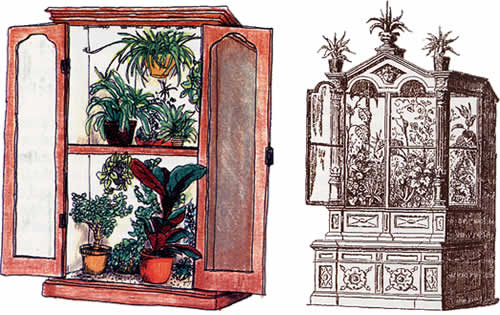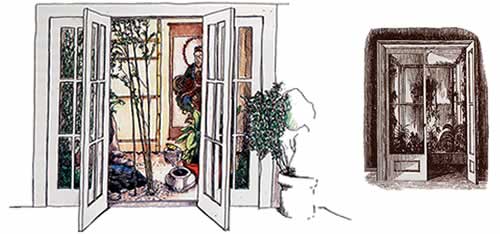Four Indoor Garden Designs
In the mid-19th century, a craze for cultivating exotic plants indoors swept England. The Victorian home was more agreeable for plants than most modern living quarters because it was not overheated, but less agreeable because it was so dark. People filled their homes with freshly imported flora from all over the world, displaying their treasures in myriad inventive new ways. The plans I suggest for creating intriguing indoor gardens are actually based on Victorian examples that are just as fresh and innovative today as they were a century and a half ago.
The indoor landscape can form an integral part of your interior and, naturally, reflect your personal preference and style. Do you want your landscape to be a strong focal point within the room, or perhaps be more subdued and neutral? How should you consider different leaf and flower colors? Plants with dark or light green, gray, or variegated leaves tend to add a relaxed ambience to a room—philodendrons, variegated Ficus or Polyscias, Podocarpus, or Cereus are a few examples. Bold colors, such as red, yellow, and orange provide dramatic effects and statements—furnished by crotons, caladiums, marantas, coleus, or bright-blossomed anthuriums, hibiscus, or orchids.
Whatever your preference, you need to provide a hospitable environment and establish a suitable space. Air circulation, room temperature, moisture, and ambient light sources must all be taken into account. Select plants that are slow growing and pruning-tolerant. Consider shrubs or large foliage plants if height is not a real issue. Use columnar-growing plants (such as Afrocarpus falcata or pole-trained vining aroids) for tall, narrow spaces and short, wide plants (Philodendron bipinnatifidum or Ficus deltoidea) for roomier quarters.
Think about layering plants in the fore-, middle-, and background. Have shorter plants grow at the bases of taller plants, as they would in nature. Avoid lining up plants in rows without regard for form, color, and foliage texture. You may want to switch flowering plants, such as orchids, into the indoor garden when they are in bloom and then move them to another location once their flowers are spent.
Think, too, about the containers you are going to use. They should blend with the color and style of your interior and shouldn't steal the show unless they are to be the focal point of the design.
Armoire Garden
The idea of creating a miniature landscape in a piece of furniture dates back to Victorian times, as is witnessed by archival illustrations from the mid- to late 1800s, depicting lushly planted miniature oases. These idealized visions of Victorian gardeners can actually become reality today with the right grow lamps to provide the necessary light and electric fans to keep the air circulating in a small enclosed space.

When converting an armoire into a plant cabinet, you need to protect it against humidity. Paint the interior walls with a light-reflecting, waterproof paint, or better yet, line the walls with galvanized sheet-metal panels, making sure that the seams are sealed with silicone aquarium glue. Make a two-inch sheet-metal pan for the bottom of the cabinet and interior shelves to catch any water that drips from pots. Each pan should be filled with stones to keep the pots above the water level. The pans will help keep the plants in an environment of raised humidity.
Mount fluorescent lamps in the top of the cabinet and underneath any interior shelves, alternating between warm and cool white light bulbs or tubes in each section. Attach a board to the front of any interior shelves to hide the light fixtures from view. Use fluorescent lamps in a small cabinet because they emit less heat and are thinner than incandescent bulbs.
If the doors have glass panels, they can be shut to further increase the humidity. A small fan should be installed above each group of plants to move the air and hinder the growth of fungus.
Window Garden
The usual place for houseplants is the windowsill. Often it is too small for the number of plants collected by the true plantoholic and does not provide enough light for the plants you want to grow.
Taking an idea from a Victorian illustration, the inventive gardener can increase the window space by building a glass-enclosed "window box" that juts out into the room. Build a wooden structural frame and fit it with ¼-inch thick glass panels on the top, one side, and the front. Fit the second side with a glazed door that allows access to the plants and can be opened to regulate heat and humidity. Line the bottom and the sides of the box with galvanized sheet-metal and fill thebottom pan with a one-inch layer of stones. Plants can be set on the base or mounted on brackets attached to the sides of the window frame. Cast iron gas-lamp brackets are an attractive option; they can often be found in antique stores.
If the window receives full sun, choose plants that are sun-tolerant, or control the intensity of the light that reaches sensitive plants. Either mount a fabric sunscreen or position pots of tender plants in the shade of larger sun-tolerant plants.
If the window doesn't get enough sun, you'll need to install additional lighting. Your options are fluorescent lamps in industrial fixtures, such as those sold for home workshops, or grow bulbs, which may be screwed into a hanging fixture.
Closet Garden
The Victorians created garden rooms in their homes but were limited in their plant choices by the amount of available natural light. Some old illustrations seem to be overly optimistic in terms of the plantings they suggest, but with the addition of artificial lights, they are easily implemented today, even if there is no natural light available in the space.
How about transforming a walk-in closet into a garden? The first step is to replace the solid closet doors with glass French doors. If the ceiling is high, consider a raised platform to separate the garden from the rest of the room. The space below the platform is an excellent place to install a sunken water feature, and it allows you to hide the plant containers below the "garden floor."

If the ceiling is too low to allow for a raised platform, or if it is impractical for the site, set the pond and the plants in their trays onto the floor and camouflage with artificial or real stones and smaller plants. Don't forget to check the weight limit of your floor and stay within the load limit.
Make sure to line any sunken areas and/or the surface of the floor with a waterproof rubber pool liner to catch any escaped water that could cause damage to the building structure. The sunken pool can be a fiberglass pond from a garden center mounted one inch above the floor surface. Make sure it is installed perfectly level so it does not leak into the liner below.
Set the sunken pots on stone-filled trays on the bottom liner. Be extremely careful when watering to prevent water from collecting under the plants. Remove the plants from their holes periodically and check for water accumulation. If you find water, soak it up with a large sponge.
As a finishing touch, you may want to hide the pot edges and the pool liner with pebbles. Light the garden with high intensity discharge (HID) lamps and include a fan in the design to circulate the air.
Garden Room
The most ambitious and rewarding project is to create a whole room that is dedicated to gardening. If the space has windows, they can provide for air circulation and some minimal light. You will have to install additional lighting though, as most plants are going to be too far away from the windows. Work with a combination of timer-controlled HID and incandescent grow lights to give the plants the amount of light they need. Fans help circulate the air.
The walls should be painted a light-reflecting color and may be decorated with architectural elements for an outdoor ambience. The floor should have a durable and waterproof cover to avoid damage from leaking pots and dripping hoses. A relatively inexpensive way to do this is to lay down a heavy-duty pool liner and cover it with loose-laid bricks or tiles, creating an indoor terrace. (Remember to check the weight load for your structure and do not exceed the limit, allowing for floor covering and plants.) Japanese shoji sliding panels, for example, create the feeling of an exterior window wall and separate the room from the interior space.
Group plants by size, color, texture, and form, bearing light and water requirements in mind. Place the plants in decorative pots. Custom-built wooden planters with adjustable shelving allow you to raise plants to the level you desire. In that way shorter plants can gain height and become tall enough for you to sit under. Use smaller plants to hide large containers to give the appearance of a planted landscape.
For easier maintenance, grow smaller plants in individual pots that can be moved to the bathtub or kitchen sink for a good showering. Large plants have to be cleaned in place. Close access to water is recommended. Alternatively, you may want to use a small-gauge hose, available in custom sizes up to 75 feet, that can be attached to a faucet by a removable clip-on feature.
If you are planning to use the room at night, consider installing some low-wattage light fixtures, such as outdoor garden lights, to create a pleasant atmosphere, as plant lights seem very strong and harsh at night. A focal point—for example a sculptural form or even a splashing wall fountain—can finish the outdoor feel of the room. Small flowering plants and cut flowers complete the illusion of a country garden room.


